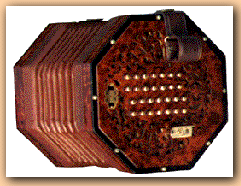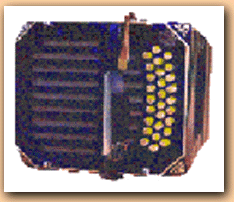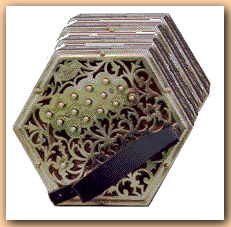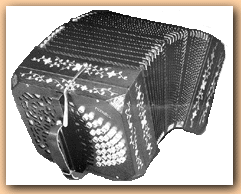

 Send
us information on Concertinas Send
us information on Concertinas
|
|
Concertinas
have a unique shape, ranging from four to twelve sides (in cross-section).
Concertinas have two keyboards, one at each end of the instruments
bellows. There are no fixed chords on a concertina; all of the
buttons are individual notes. The number of notes and systems
vary so greatly that a player of one system will almost certainly
not be able to pick up a concertina of a different system and
play it without having to almost learn it from scratch. Each
side of the instrument has its own finger, thumb or wrist strap
and when in use it is usually supported on the knee. With compact
size and light weight, the concertina can be visually entertaining,
as players are able to move around with ease. This is one of
the things that has made it very popular.
|
| English
Concertina
|
Created
in the 1830's by Charles Wheatstone, the English Concertina
has a distinctive hexagonal or octagonal shape. It can be recognised
by the 4 parallel rows of buttons and by the supports for thumb
and little finger on each end. The larger baritone and bass
English concertinas frequently have wrist straps as well, to
help with the greater weight of the instrument. It was originally
intended to play violin melodies, because it is able to play
legato. The two centre rows on each side are in the key of C
and the accidentals are distributed between the outside rows.
Playing a scale involves alternating between the left and the
right hands. The layout of buttons however, allows the player
to play at very fast tempos. The English concertina has 48 keys,
with a range of 3½ octaves. Some models have 56 keys, with
the extra 8 keys at either the top or bottom of the scale.
|
 |
| German
Concertina (Chemnitzer) |
 |
Invented
in 1834 by Carl Friederich Uhlig, the main physical difference
of the German Concertina is that it has a square shape. It is
related to the bandoneon, being square or slightly rectangular.
It was based on a diatonic, with two rows on each side of the
instrument. Each additional row is tuned a fifth higher.
|
| Anglo-German
Concertina
|
The Anglo-German
Concertina is also known as simply the Anglo Concertina. During
the 1850's George Jones incorporated the English Concertina
and the German Concertina into the Anglo-German Concertina.
Along with the English Concertinas shape and the German Concertina
note system, he also added an extra row of buttons. The extra
row consisted of accidentals making the instrument fully chromatic.
The most common configuration is the C/G Anglo where the outside
row (or middle row on three row) plays the key of C and the
inside row plays a key of G. The different types of Anglo are
based on the number of buttons. A two row Anglo has 20 buttons
and with each row in a different key it is capable of playing
in two keys. The three row has up to 40 buttons, and the row
configuration is the same, except that the third outside row
is assorted accidentals so that the skilled player can play
in other keys.
|
 |
| Duet
Concertina |
Duet Concertinas
enables the player to play a melody line in the right hand and
an accompaniment in the left hand (similar to that of a standard
bass accordion). There have been several systems and key layouts
invented, all with a seperate way of achieving this.
|
| Bandoneon
|
 |
The Bandoneon
is based on the German Concertina. With 72 or more buttons the
Bandoneon has a larger range of notes, usually up to 4½
octaves, with several different layouts. It can be either diatonic
or chromatic. It is especially popular in South America, where
they are played in tango orchestras.
|
Home |
Weekly News |
Yellow Pages |
Sites Hosted |
Services |
Search AWW |
Contact
to
comment on these pages, e-mail the webmaster
|